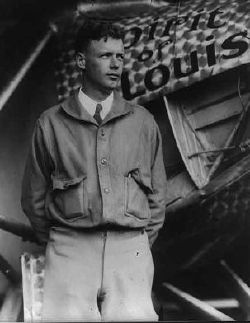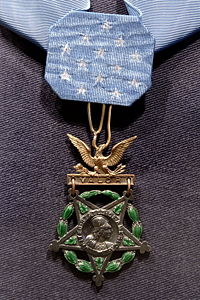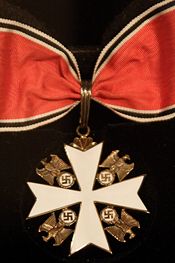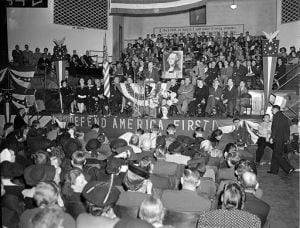Charles Lindbergh
This article is about the 20th-century aviator.
| Charles Lindbergh |
|---|
| Born |
| February, 1902 Detroit, Michigan |
| Died |
| August 26, 1974 Kipahulu, Maui, Hawaii |
Charles Augustus Lindbergh (February 4, 1902 – August 26, 1974), was an American aviator famous for piloting the first non-stop solo flight from New York to Paris in 1927; an event that brought him unprecedented international celebrity, due to the emerging role of mass media in the lives of the public. Known as "The Lone Eagle," his brave sojourn across the lonely Atlantic Ocean, a feat perhaps only eclipsed by man’s first walk on the moon, opened the way for a new era in aviation, which in turn, transformed our planet by heralding in a new age of global communications and travel.
The trajectory of his life would take Lindbergh from the Herculean heights of a hero - of unparalleled fame in the annals of American culture - to the lowest depths of victimization when his son was kidnapped and murdered in what was called the "crime of the century."
In the years prior to World War II, Lindbergh was a noted isolationist, and was a leader in the movement to keep the U.S. out of the coming war. In 1953 his autobiographical account of his flight, The Spirit of St. Louis, won the Pulitzer Prize and his unpopular stance during the war years became less of an issue to the American public. Lindbergh spent his final years as an ardent conservationist championing the rights of lands, animals, and indigenous peoples like the Tasaday tribal group of the Philippines.
Early Life
Charles Augustus Lindbergh was born in Detroit, Michigan, the son of Swedish immigrants. His father, Charles Lindbergh Sr., was a lawyer and later a U.S. Congressman who opposed the entry of the U.S. into World War I; his mother, Evangeline Lodge Land was a teacher.
His family owned a small farm in Minnesota and early on, Lindbergh demonstrated mechanical aptitude and a passion for science. In 1922 he quit college at the University of Wisconsin-Madison, due partly to poor grades, and joined a pilot training program with Nebraska Aircraft. He bought his own plane, a World War I-surplus Curtiss JN-4 "Jenny," and became a barnstormer, engaging in stunts and parachute jumps in his spare time."[1] In 1924 he started training as a pilot with the Army Air Service.
Lindbergh's first job was as chief pilot of an airmail route operated by Robertson Aircraft in St. Louis, Missouri. As a mail pilot - a dangerous job in those times - he developed a reputation for delivering the mail even under severe weather conditions.
First non-stop flight New York to Paris
In 1919, Frenchman and hotelier, Raymond Orteig offered a $25,000 prize known as the Orteig Prize, to the first pilot to fly from New York City to Paris. His offer ignited intense interest worldwide. Either an easterly flight from New York City or a westbound flight from Paris would qualify, consequently, the first challengers were French war heroes, Captain Charles Nungesser and Raymond Coli, who took off on May 8, 1927 on a westbound flight in the L'Oiseau Blanc. Their aircraft disappeared after they last made contact crossing the coast of Ireland. Other teams, including famed W.W.I French "ace" René Fonck, and American aviators Clarence Chamberlin and Admiral Richard E. Byrd, joined in the race to claim the Orteig Prize. The competition became even deadlier when Americans Noel Davis and Stanton H. Wooster were killed when their plane American Legion crashed during a test-run just days before their departure.
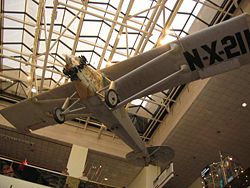
The famous insurance company Lloyds of London was forecasting odds of ten to one against a successful flight across the Atlantic Ocean and Lindbergh, just 25 years old and relatively inexperienced, was regarded as the "dark horse."[2]Lindbergh went to great lengths to lighten his load for the trip, even emptying pages from his flight log, in order to carry as much fuel as possible.[3]
His meticulous attention to detail and preparation paid off when he succeeded in flying solo non-stop from New York to Paris in just 33.5 hrs. When he landed his plane The Spirit of St. Louis in Paris on May 21, 1927, the shy unassuming pilot became an overnight hero.[3] Besieged by the press and an estimated crowd of 150,000, Lindbergh was received by the President of France who bestowed on him the French Legion of Honor. Upon his arrival back in the United States a fleet of warships and aircraft escorted him to Washington, D.C. where President Calvin Coolidge awarded him the Distinguished Flying Cross on June 11, 1927.
Lindbergh's accomplishment won him the Orteig Prize; however, more significant than the prize money was the acclaim that resulted from his daring flight. A ticker-tape parade was held for him down Fifth Avenue in New York City on June 13, 1927. On March 21, 1929 he was presented the Medal of Honor for his historic trans-Atlantic flight.
The massive publicity surrounding him and his flight boosted the aircraft industry and made a skeptical public take air travel seriously. An intensely private person, his life would never be the same, nor would life on the planet earth.[2]
Marriage, children, kidnapping
Charles Lindbergh met Anne Morrow Lindbergh after being invited to visit her vacationing family in Mexico. Her father, Dwight Morrow, was soon to be Ambassador to Mexico. After only four dates the couple were married on May 27, 1929. Catapulted as they were into the public eye, flying - "going up" - became their only recourse to the massive publicity that dogged their every move. Lindbergh subsequently taught his new wife how to fly and did much of his exploring and charting of air routes with her at his side. The couple had six children: Charles Augustus Lindbergh III (1930-1932), Jon Lindbergh (b. 1932), Land Morrow Lindbergh (b. 1937) Anne Lindbergh (1940-1993), Scott Lindbergh (b. 1942) and Reeve Lindbergh (b. 1945), a writer.
Their first born child, Charles Augustus Lindbergh III, 20 months old, was abducted on March 1, 1932, from the Lindbergh home. After a nationwide ten-week search and ransom negotiations with the kidnappers, an infant corpse, identified by Lindbergh as his son, was found on May 12 in Jefferson, New Jersey, just a few miles from the Lindberghs' home. More than three years later, a media circus ensued when the man accused of the murder, Bruno Hauptmann, went on trial. Tired of being in the spotlight and still mourning the loss of their son, the Lindberghs moved to Europe in December 1935. Hauptmann, who maintained his innocence until the end, was found guilty and was executed on April 3, 1936. His case, based largely on circumstantial evidence, lacked closure without a confession. Courtroom cameras would be banned for another 60 years following the heretofore unprecedented coverage of the trial that was broadcast into American homes on the newly invented television set.[2]
Pre-war activities
In Europe, during the pre-war period, Lindbergh traveled to Germany several times at the behest of the U.S. military, where he made visits to their air force, the Luftwaffe. Lindbergh was impressed with Germany's growing military strength and reported back that they were taking a leading role in a number of aviation developments, including metal construction, low-wing designs, dirigibles, and Diesel engines. In his premonitory warning to the U.S. government Lindbergh stated that, " …Germany was now able to produce military aircraft faster than any European country."[2]
In 1929, Lindbergh became interested in the work of U.S. rocket pioneer Robert Goddard. The following year Lindbergh helped Goddard secure his first endowment from Daniel Guggenheim, which allowed Goddard to expand his independent research and development. Lindbergh remained a key supporter and advocate of Goddard's work in an era when rockets were not viewed as practical additions to aircraft, much less considered for flights into space.[2]
The Lindberghs lived in England and Brittany, France during the late 1930s in order to find tranquility and avoid the celebrity that besieged them after the kidnapping trial. Concerned for the safety of their other children they strongly shunned publicity; many Americans mourned the fact that the Lindberghs felt compelled to leave and find safe haven in another country.[2]
While living in France, Lindbergh worked with Nobel Prize-winning French surgeon Dr. Alexis Carrel. Carrel had collaborated on earlier projects with Lindbergh while he lived in the U.S. and worked for the Rockefeller Institute of Medical Research. In 1930 Lindbergh's sister-in-law, Elizabeth, suffered a debilitating heart condition that prompted Lindbergh to wonder why it was not possible to repair hearts with surgery. Working with Dr. Carrel, who became a mentor to Lindbergh, he discovered it was because organs could not be kept alive outside the body. He then began working on a solution to the problem with Carrel. Lindbergh's invention, a glass perfusion pump, has been credited with making future heart surgeries possible. The device in this early stage was far from perfect as perfused organs survived well for a few days but then began to show progressive degenerative changes.[4] Carrel also introduced Lindbergh to eugenics, which would become one of the controversial theories that helped shape Lindbergh's foreign policy views.[5]
In 1938, Lindbergh and Carrel collaborated on a book, The Culture of Organs, which summarized their work on perfusion of organs outside the body. Lindbergh and Carrel discussed an artificial heart but it would be decades before one was actually built.
The Medal Controversy
Lindbergh's continued involvement with German aviation brought him back into the American spotlight in 1938. The American ambassador to Germany, Hugh Wilson, invited Lindbergh to a dinner with Hermann Göring at the American embassy in Berlin. The dinner included diplomats and three of the greatest minds of German aviation, Ernst Heinkel, Adolf Baeumaker and Dr. Willy Messerschmitt.[2] Goering presented Lindbergh with the Service Cross of the German Eagle for his services to aviation and particularly for his 1927 flight. Soon, however, his acceptance of this medal would create a furor back home as the atrocities of Nazi Germany came to light. Lindbergh declined to return the medal to the Germans because he claimed that to do so would be "an unnecessary insult" to the German Nazi government. This occurred prior to the United States getting involved in the war with Germany. Lindbergh returned to the United States and the controversy over his politics, influenced strongly by what he observed in Europe, continued. [2]
Lindbergh and Nazi Germany
Due to his numerous scientific expeditions to Nazi Germany, Lindbergh was labeled a Nazi sympathizer by the press. Consequently, after the war broke out, President Franklin D. Roosevelt banned him from joining the military. Lindbergh's subsequent combat missions as a civilian consultant and volunteer pilot restored his reputation with the American public, but only partially. His Pulitzer Prize winning biographer A. Scott Berg (Lindbergh) contends that Lindbergh was not so much a supporter of the Nazi regime as someone impressed with their strength, and being relatively inexperienced in political maneuvering, he easily allowed rivals to portray him as one. Berg goes on to say that in his support for the America First Committee he was merely giving voice to the sentiments of other Americans who opposed entry into World War II. Lindbergh was critical of Nazi Germany's treatment of Jews, saying in 1941, that "no person with a sense of dignity of mankind can condone." but he urged them in his 1941 speech in Des Moines, Iowa to avoid involvement with "war agitators"[6] Lindbergh's real fear was that destroying a powerful European nation like Germany could lead to the downfall of Western Civilization and a rise in Communist supremacy over Europe. Lindbergh, rather than realizing the threat Nazi Germany presented, instead warned of the dangers of Russia's aggression towards Europe. Ironically, Russia would become an ally of the Allied Powers during World War II.
America First and anti-war activities
As World War II began in Europe, Lindbergh became a prominent speaker in favor of non-intervention, going so far as to recommend that the United States negotiate a neutrality pact with Germany during his January 23, 1941 testimony before Congress. He joined the antiwar America First Committee and soon became its most prominent public spokesman, speaking to overflow crowds in Madison Square Garden in New York City and Soldier Field in Chicago.
In a speech at an America First rally on September 11, 1941 in Des Moines, Iowa entitled "Who Are the War Agitators?" Lindbergh claimed that three groups had been "pressing this country toward war: the Roosevelt Administration, the British and the Jews" and complained about what he insisted was the Jews' "large ownership and influence in our motion pictures, our press, our radio and our government." Although he made clear his opposition to German anti-Semitism, stating that "All good men of conscience must condemn the treatment of the Jews in Germany," his inability to unequivocally condemn Nazi Germany put him in the position of condoning, in the minds of many, their actions.[2]
There was widespread negative reaction to this speech and Lindbergh was forced to defend and clarify his comments. While claiming he was not anti-Semitic he also would not retract his statements. Lindbergh resigned his commission in the U.S. Army Air Corps when President Roosevelt openly questioned his loyalty. After the attack on Pearl Harbor in 1941, Lindbergh attempted to return to the Army Air Corps, but was denied when several of Roosevelt's cabinet secretaries registered objections. Determined to find a way to serve his country, Lindbergh sought special consultative status in the private sector.
World War II and military service
Charles Lindbergh began assisting with the war effort by serving as a civilian consultant to Ford Motor Company in 1942, where he worked at the Willow Run B-24 production line. Later in 1943, he joined United Aircraft as an engineering consultant. The following year, he persuaded United Aircraft to designate him a technical representative in the Pacific War to study aircraft performances under combat conditions. He showed Marine F4U pilots how to take off with twice the bomb load that the aircraft was rated for and on May 21, 1944 he flew his first combat mission.[7].
In his six months in the Pacific in 1944, Lindbergh took part in fighter bomber raids on Japanese positions, flying about 50 combat missions (again as a civilian). His innovations in the use of P-38s impressed a supportive General Douglas MacArthur.[8] Despite the long range improvement exhibited by the P-38 Lightning, leading to missions such as the one that killed Admiral Yamamoto, Lindbergh's contributions included engine-leaning techniques that he introduced to P-38 Lightning pilots. These techniques greatly improved fuel usage while cruising, enabling the aircraft to fly even longer-range missions. On July 28, 1944 during a P-38 bomber escort mission with the 475th Fighter Group, Fifth Air Force, in the Ceram area, Lindbergh is credited with shooting down a Sonia observation plane piloted by Captain Saburo Shimada, Commanding Officer of the 73rd Independent Chutai[9][7] The U. S. Marine and Army Air Force pilots who served with Lindbergh admired and respected him, praising his courage and defending his patriotism regardless of his politics.[10] Lindbergh stated once that he always prayed for the soul of the Japanese pilot he shot down; additionally he was to be deeply affected by the war atrocities he witnessed.[2]
Later life
After World War II he and his family lived in Connecticut, while also building homes in Switzerland and Hawaii. Lindbergh, forever peripatetic, traveled extensively as a consultant both to the chief of staff of the U.S. Air Force and to Pan American World Airways. Dwight D. Eisenhower restored Lindbergh's assignment with the Army Air Corps and made him a Brigadier General in 1954. That same year he served on the congressional advisory panel set up to establish the site of the United States Air Force Academy. In December 1968, he visited the crew of Apollo 8 on the eve of the first manned spaceflight to leave earth's orbit.
From the 1960s on Lindbergh became an advocate for the conservation of the natural world, campaigning to protect endangered species like humpback and blue whales. He was also instrumental in establishing protections for the "primitive" Filipino group the Tasaday and African tribes, and for supporting the establishment of a national park. While studying the native flora and fauna of the Philippines, he also became involved in an effort to protect the Philippine eagle. In his final years, Lindbergh was troubled that the world was out of balance with its natural environment; he stressed the need to regain that balance.
Lindbergh's speeches and writings later in life emphasized his love of both technology and nature, and a lifelong belief that "all the achievements of mankind have value only to the extent that they preserve and improve the quality of life." In the Christmas 1967 edition of LIFE magazine, Lindbergh was quoted as saying, "The human future depends on our ability to combine the knowledge of science with the wisdom of wildness."[2]
Although he traveled extensively, Lindbergh spent time during his final years on the Hawaiian island of Maui. Aware that he was dying he arranged to be transported to his home there where he oversaw every aspect of the final stages of his illness, the planning of his memorial service, and his burial.[2] He succumbed to cancer on August 26, 1974 and was laid to rest at the Palapala Ho'omau Church in Kipahulu, Maui.
Legacy
In honor of Charles and his wife Anne Morrow Lindbergh's vision of achieving balance between the technological advancements they helped pioneer and their work to preserve human and natural environments the Lindbergh Award was established in 1978 by the Lindbergh Foundation and is given annually to those whose work has made a significant contribution toward the concept of "balance."
Since 2002, the annual Lindbergh-Carrel Prize[11] is awarded at a Charles Lindbergh Symposium for an outstanding contribution to development of perfusion and bioreactor technologies for organ preservation and growth.
Lindbergh is also recognized in the field of aviation for demonstrating and charting polar air-routes, improving upon high altitude flying techniques, and for increasing aircraft flying range by decreasing fuel consumption. These innovations were to become the basis for all modern intercontinental air travel.
Lindbergh in pop culture
- Shortly after Lindbergh made his famous flight, the Stratemeyer Syndicate began publishing the Ted Scott Flying Stories (1927- 1943) by Franklin W. Dixon wherein the hero was closely modeled after Lindbergh.
- A song called "Lucky Lindy" was released soon after the 1927 flight. Tony Randall, not particularly known for singing, but a fan of old songs, revived it in the 1960s in a collection of jazz-age and depression era songs that he recorded.
- The dance craze, the "Lindy Hop" was named after him and became popular after his flight.
- The Agatha Christie book (1934) and movie Murder on the Orient Express (1974) begin with a fictionalized depiction of the Lindbergh baby kidnapping.
- Verdensberømtheder i København (1939) was an English/Danish co-production starring Robert Taylor, Myrna Loy and Edward G. Robinson featured Charles A. Lindbergh as himself.
- James Stewart played Lindbergh in the biographical The Spirit of St. Louis (1957), directed by Billy Wilder. The film begins with events leading up to the flight before giving a gripping and intense depiction of the flight itself.
- British Sea Power wrote, recorded and released (2002) a song in his honor entitled "Spirit of St Louis."
- A fictional version of Lindbergh is a major character in Philip Roth's 2004 alternative history novel, The Plot Against America. In Roth's narrative, Lindbergh successfully runs against Roosevelt in the 1940 U. S. presidential election and aligns his country with the Nazis. This portrayal engendered great controversy.
Notes
- ↑ Leonard Mosley, Lindbergh: A Biography (New York; Doubleday and Company, 1976, ISBN 0385095783), 46.
- ↑ 2.00 2.01 2.02 2.03 2.04 2.05 2.06 2.07 2.08 2.09 2.10 2.11 A. Scott Berg, Lindbergh (New York: G.P. Putnam's Sons, 1998, ISBN 0399144498).
- ↑ 3.0 3.1 "Charles A. Lindbergh" in Contemporary Heroes and Heroines, Edited by Ray B. Browne, et al. (Gale Research, 1990).
- ↑ Chapter from Edmunds' book/video Extracorporeal Perfusion, Alexis Carrel, and Charles Lindbergh.
- ↑ American Experience, Arthur Schlesinger Interview on: Lindbergh Accepting a Nazi Medal PBS Documentary "Lindbergh". Retrieved June 24, 2008.
- ↑ Speech in Des Moines, primary resources for documentary film "Lindbergh". PBS.org. Retrieved June 24, 2008.
- ↑ 7.0 7.1 Peter B. Mersky, U.S. Marine Corps Aviation - 1912 to the Present (Annapolis, MD: Nautical and Aviation Publishing Company of America, 1997, ISBN 1877853429), 93.
- ↑ Peter Dunn website Charles Augustus Lindbergh helps the 5th Air Force in WWII. Retrieved June 24, 2008.
- ↑ Dick Beard, El Reno, OK, Charles Lindbergh and the 475th Fighter Group, Charles Lindbergh, An American Aviator. charleslindberg.com. Retrieved March 24, 2007.
- ↑ Dick Beardm El Reno, OK, Lindbergh Flew with Us (307th Bomb Group)!. charleslindberg.com. Retrieved June 24, 2008.
- ↑ Lindbergh-Carrel Prize Retrieved June 24, 2008.
ReferencesISBN links support NWE through referral fees
- Berg, A. Scott. Lindbergh. New York: G.P. Putnam's Sons, 1998. ISBN 0399144498.
- Birdsall, Steve. Flying Buccaneers. Garden City, New York: Doubleday & Company, 1977, 194-196. ISBN 0385032188
- "Charles A. Lindbergh." Contemporary Heroes and Heroines, Edited by Ray B. Browne. Gale Research, 1990.
- Cole, Wayne S. Charles A. Lindbergh and the Battle Against American Intervention in World War II. New York: Harcourt Brace Jovanovich, 1974. ISBN 0151181683.
- Gill, Brendan. Lindbergh Alone. New York: Harcourt Brace Jovanovich, 1977. ISBN 0151524017.
- Lindbergh, Charles A. Charles A. Lindbergh: Autobiography of Values. New York: Harcourt Brace Jovanovich, 1977. ISBN 0151102023.
- Lindbergh, Charles A. We. New York: Grosset & Dunlap Publishers, 1927. (autobiographical)
- Mersky, Peter B. U.S. Marine Corps Aviation - 1912 to the Present, third ed. Annapolis, Maryland: Nautical and Aviation Publishing Company of America, (original 1983) 1997. ISBN 1877853429
- Milton, Joyce. Loss of Eden: A Biography of Charles and Anne Morrow Lindbergh. New York, Harper Collins, 1993. ISBN 0060165030.
- Mosley, Leonard. Lindbergh: A Biography. New York; Doubleday and Company, 1976. ISBN 0385095783
- Wallace, Max. The American Axis: Henry Ford, Charles Lindbergh, and the Rise of the Third Reich. St. Martin's Press, 2003. ISBN 0312290225
External Links
All links retrieved December 4, 2023.
- The Charles A. and Anne Morrow Lindbergh Foundation.
- Ranfranz, Pat. 1998-2007. Charles Lindbergh an American Aviator.
- WGBH. 1999. Lindbergh PBS.The American Experience.
- Charles A. Lindbergh at the Internet Movie Database
- Chesler, Ellen. 1993. Better Above Than Below New York Times.
Credits
New World Encyclopedia writers and editors rewrote and completed the Wikipedia article in accordance with New World Encyclopedia standards. This article abides by terms of the Creative Commons CC-by-sa 3.0 License (CC-by-sa), which may be used and disseminated with proper attribution. Credit is due under the terms of this license that can reference both the New World Encyclopedia contributors and the selfless volunteer contributors of the Wikimedia Foundation. To cite this article click here for a list of acceptable citing formats.The history of earlier contributions by wikipedians is accessible to researchers here:
The history of this article since it was imported to New World Encyclopedia:
Note: Some restrictions may apply to use of individual images which are separately licensed.
